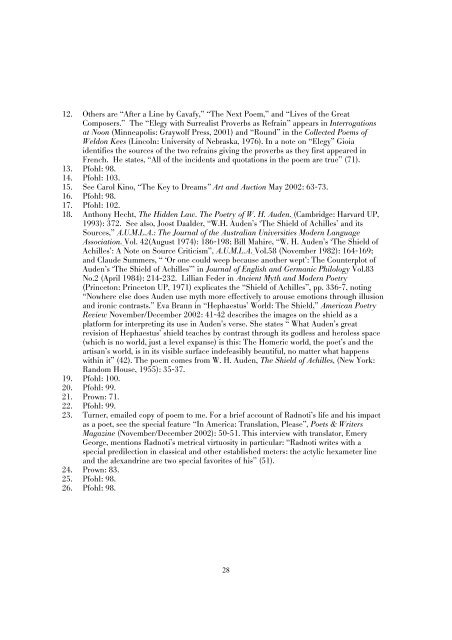SECTION 1 - via - School of Visual Arts
SECTION 1 - via - School of Visual Arts
SECTION 1 - via - School of Visual Arts
Create successful ePaper yourself
Turn your PDF publications into a flip-book with our unique Google optimized e-Paper software.
12. Others are “After a Line by Cavafy,” “The Next Poem,” and “Lives <strong>of</strong> the Great<br />
Composers.” The “Elegy with Surrealist Proverbs as Refrain” appears in Interrogations<br />
at Noon (Minneapolis: Graywolf Press, 2001) and “Round” in the Collected Poems <strong>of</strong><br />
Weldon Kees (Lincoln: University <strong>of</strong> Nebraska, 1976). In a note on “Elegy” Gioia<br />
identifies the sources <strong>of</strong> the two refrains giving the proverbs as they first appeared in<br />
French. He states, “All <strong>of</strong> the incidents and quotations in the poem are true” (71).<br />
13. Pfohl: 98.<br />
14. Pfohl: 103.<br />
15. See Carol Kino, “The Key to Dreams” Art and Auction May 2002: 63-73.<br />
16. Pfohl: 98.<br />
17. Pfohl: 102.<br />
18. Anthony Hecht, The Hidden Law. The Poetry <strong>of</strong> W. H. Auden. (Cambridge: Harvard UP,<br />
1993): 372. See also, Joost Daalder, “W.H. Auden’s ‘The Shield <strong>of</strong> Achilles’ and its<br />
Sources,” A.U.M.L.A.: The Journal <strong>of</strong> the Australian Universities Modern Language<br />
Association. Vol. 42(August 1974): 186-198; Bill Mahire, “W. H. Auden’s ‘The Shield <strong>of</strong><br />
Achilles’: A Note on Source Criticism”, A.U.M.L.A. Vol.58 (November 1982): 164-169;<br />
and Claude Summers, “ ‘Or one could weep because another wept’: The Counterplot <strong>of</strong><br />
Auden’s ‘The Shield <strong>of</strong> Achilles’” in Journal <strong>of</strong> English and Germanic Philology Vol.83<br />
No.2 (April 1984): 214-232. Lillian Feder in Ancient Myth and Modern Poetry<br />
(Princeton: Princeton UP, 1971) explicates the “Shield <strong>of</strong> Achilles”, pp. 336-7, noting<br />
“Nowhere else does Auden use myth more effectively to arouse emotions through illusion<br />
and ironic contrasts.” Eva Brann in “Hephaestus’ World: The Shield,” American Poetry<br />
Review November/December 2002: 41-42 describes the images on the shield as a<br />
platform for interpreting its use in Auden’s verse. She states “ What Auden’s great<br />
revision <strong>of</strong> Hephaestus’ shield teaches by contrast through its godless and heroless space<br />
(which is no world, just a level expanse) is this: The Homeric world, the poet’s and the<br />
artisan’s world, is in its visible surface indefeasibly beautiful, no matter what happens<br />
within it” (42). The poem comes from W. H. Auden, The Shield <strong>of</strong> Achilles. (New York:<br />
Random House, 1955): 35-37.<br />
19. Pfohl: 100.<br />
20. Pfohl: 99.<br />
21. Prown: 71.<br />
22. Pfohl: 99.<br />
23. Turner, emailed copy <strong>of</strong> poem to me. For a brief account <strong>of</strong> Radnoti’s life and his impact<br />
as a poet, see the special feature “In America: Translation, Please”, Poets & Writers<br />
Magazine (November/December 2002): 50-51. This interview with translator, Emery<br />
George, mentions Radnoti’s metrical virtuosity in particular: “Radnoti writes with a<br />
special predilection in classical and other established meters: the actylic hexameter line<br />
and the alexandrine are two special favorites <strong>of</strong> his” (51).<br />
24. Prown: 83.<br />
25. Pfohl: 98.<br />
26. Pfohl: 98.<br />
28








